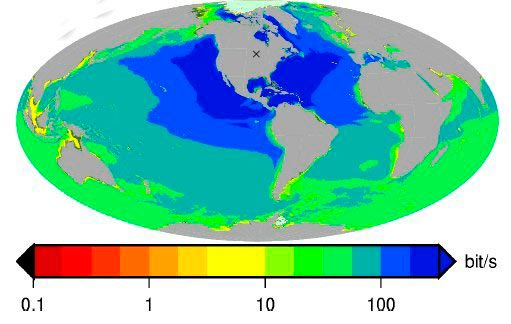
Communicating with nuclear-powered submarines – which can remain underwater essentially indefinitely – is a major challenge because seawater is opaque to most of the electromagnetic spectrum. Neutrinos have previously been proposed as a solution to this problem, because these subatomic particles can pass easily through all matter, but it was thought to be impossible to generate beams of sufficient intensity. However, a physicist in the US has now calculated that the extremely intense beams of a neutrino factory would do the job.
Nuclear-powered submarines can remain submerged for months at a time and only need to resurface to replenish food stocks or carry out maintenance. However, submarines’ movements are restricted by the need to receive messages to direct their actions. Seawater is transparent only in part of the visible portion of the electromagnetic spectrum (blue and green wavelengths) and at frequencies below about 100 Hz. Using lasers in the visible is not practical and low-frequency radio transmissions result in extremely low data rates – around one bit per minute. As a result, nuclear submarines currently communicate by floating a wire antenna close to the surface of the ocean. While this supports data rates of about 50 bits per second, it restricts the depth and speed of operation of a vessel.
Sent through the Earth
Patrick Huber of Virginia Tech believes that these problems can be overcome by instead using neutrinos. Because neutrinos interact extremely weakly with other matter, a beam of such particles can be sent through the Earth with very little loss of intensity. So a submarine could in principle pick up information encoded in a neutrino beam sent from anywhere else on the planet by detecting the neutrinos that approach it from below.
Unfortunately, neutrinos interact very weakly with matter and, therefore, generating a measurable signal requires an extremely intense beam. There are currently a number of experiments around the world that involve the transmission and detection of neutrino beams in order to measure how neutrinos “oscillate” as they travel through space, an important area of study in fundamental physics. But such facilities would be unsuited for carrying out long-range communications. For example, a beam sent from Fermilab outside Chicago to a mine around 700 km away in Minnesota results on average in just one neutrino being registered in the detector every 12 hours. As Huber points out, this rate would need to improve by a factor of about one million if neutrinos were to be used to send messages.
Huber, however, has worked out that a new kind of neutrino source that physicists hope to build within the next decade – a neutrino factory – would provide sufficient intensities. A neutrino factory would work by slamming high-energy protons into a target made of liquid mercury, with the collisions producing pions, which decay into muons, which in turn decay into muon neutrinos.
Detecting Cerenkov radiation
Huber calculates that data encoded in beams of such neutrinos could be picked up by detectors wrapped around the hull of a submarine at rates of between 1 and 100 bits per second. These detectors would either pick up the muons produced when muon neutrinos interact with the water or, more indirectly, measure the Cerenkov radiation generated by the passage of such muons through the water. Data would be encoded by chopping time up into many different slots and then sending a pulse of neutrinos within a particular slot, so that one second divided up into 16,000 slots, for example, would be equivalent to transmitting one letter out of a 16,000 letter alphabet or 14 bits (214).
A neutrino factory would not come cheap – it would cost several billion dollars. And adapting it for telecommunications might, says Huber, roughly double this price; the extra expense required to make the device rotatable so that it could point to wherever a submarine is located. But Huber believes that this price should be seen in the context of the money already spent on nuclear submarines by the US, with the 14 Trident vessels, including missiles, costing some $150bn. “There are many things I would not have thought a government would spend very large amounts of money on,” he adds. “So I would not expect anyone to actually build such a system. But I would not be surprised if someone wanted to do more research on it.”
The work is described on the arXiv preprint server.



